TRITON XXVI
In Conjunction with the 51st Annual New York International
A Selection of Roman Bronzes





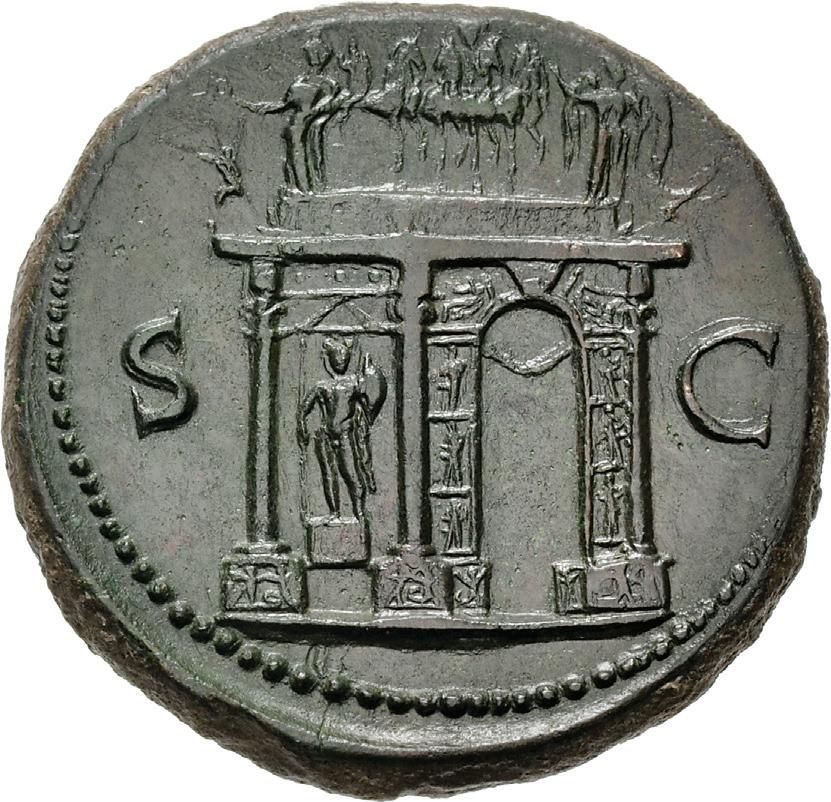

Barclay Salon, Lobby Level
InterContinental New York Barclay, 111 East 48th Street, New York
PO Box 479, Lancaster, PA 17608-0479

Phone (717) 390.9194 Fax (717) 390.9978
20 Bloomsbury Street, London WC1B 3QA, UK
Lancaster, PA
Auction lots may be viewed at our Lancaster Office from December 1, 2022 until January 5, 2023, by appointment only, unless the lots are on exhibition at the showings below. Lancaster Office Hours: 10 AM - 5 PM (Monday - Friday).
Please note that our hours will be limited during the holiday season.
InterContinental New York Barclay Morgan Suite, Mezzanine Level Sunday, January 8, 2023 - 1 PM until 7 PM Monday, January 9, 2023 - 9 AM until 7 PM Tuesday, January 10, 2023 - 8 AM until 6 PM Wednesday, January 11, 2023 - 8 AM until Noon

Enlargements of all single lots and selected multiple lots may be viewed on the internet at
NumisBids.com
CNGCOINS.COM SIXBID.COM
We are sorry, but photographs of individual coins in multiple lots cannot be provided
Session One – Tuesday Morning – January 10 – 9:00 AM
Celtic Coinage .................................................... 1–10 Greek Coinage (part 1) ............................................ 11–334
Session Two – Tuesday Afternoon – January 10 – 2:00 PM
Greek Coinage (part 2) ........................................... 335–449
Oriental Greek Coinage .......................................... 450–499
Central Asian Coinage ........................................... 500–531
Roman Provincial Coinage........................................ 532–596
Roman Republican & Imperatorial Coinage 597–673
Session Three – Wednesday Morning – January 11 – 9:00 AM
Roman Imperial Coinage ........................................ 674–897
Byzantine Coinage 898–979
Early Medieval Coinage 980–990
Session Four – Wednesday Afternoon – January 11 – 2:00 PM
World Coinage ................................................ 991–1157
World Medals 1158–1183
British Coinage 1184–1295
British Medals ............................................... 1296–1299
Large Lots .................................................. 1300–1315
Session 2 – Tuesday, January 10, 2023 — 2 PM
671. The Triumvirs. Octavian and Divus Julius Caesar. 38 BC. Æ Sestertius or Dupondius (29mm, 18.61 g, 4h). Southern Italian(?) mint. Bare head of Octavian right, wearing slight beard; CAeÍAr downward to right; Diui • F downward to left / Laureate head of Divus Julius Caesar right; DiuOÍ downward to right; iuLiuÍ downward to left. Crawford 535/1; Alföldi & Giard 4 (D2/R- [unlisted rev. die]); CRI 308; Sydenham 1335; RPC I 620; BMCRR Gaul 106; Kestner 3826-8; RBW 1822. Green patina, minor deposits. Good VF. Well struck for issue. ($5000)
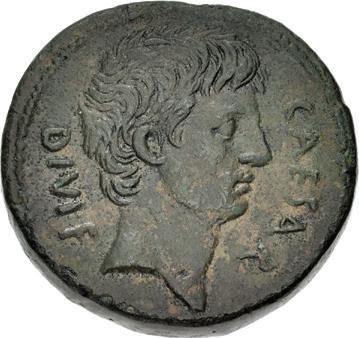


From the DMS Collection, purchased from Jonathan K. Kern, 2012. Ex Triton XI (8 January 2008), lot 633.


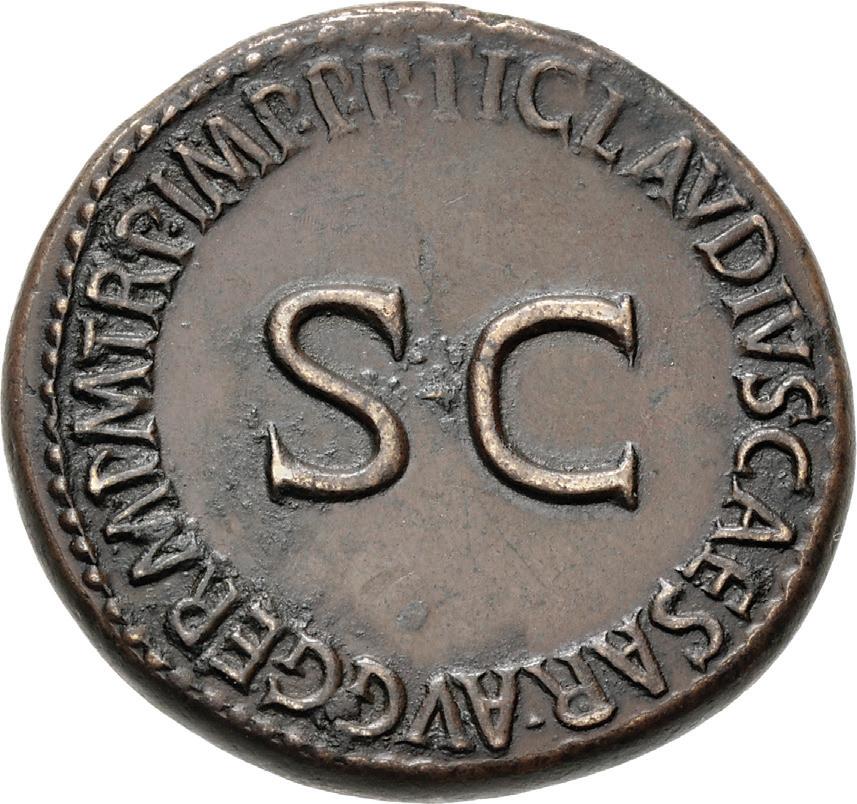
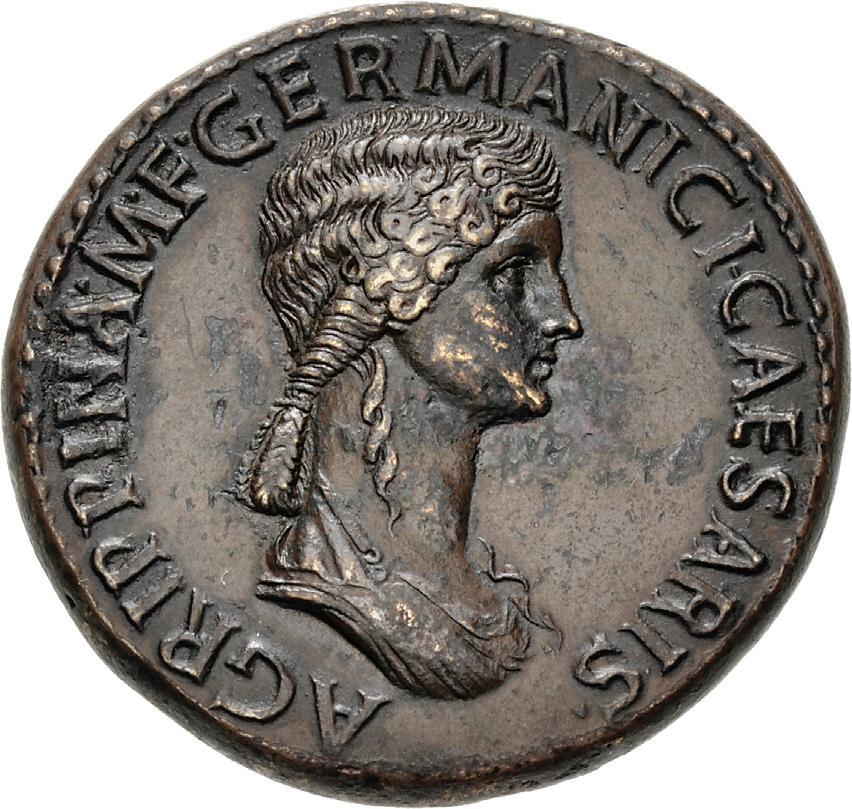

698. Claudius. AD 41-54. Æ Sestertius (36mm, 27.43 g, 7h). Rome mint. Struck AD 41-42. TI CLAVDIVS CAESAR AVG P M TR P IMP, laureate head right / EX S C/ O B/ CIVES/ SERVATOS in four lines within oak wreath. RIC I 96; von Kaenel Type 54; BMCRE 115-6; BN 152-61. Even, natural brown patina. EF. ($10,000)



From the DMS Collection, purchased from David Vagi, March 2002.
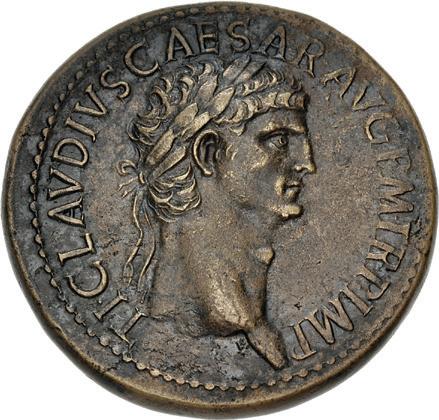
703. Nero. AD 54-68. Æ Sestertius (34mm, 27.96 g, 6h). Lugdunum (Lyon) mint. Struck circa AD 65. NERO • CLAVD • CAESAR • AVG • GER • P • M • TR • P • IMP • P • P, laureate head right, globe at point of neck / S C across field, Triumphal arch, hung with wreath across front and left side; above, Nero in facing quadriga escorted on right by Victory holding wreath and palm and on left by Pax holding caduceus and cornucopia; just below the quadriga on extreme left and right, two small figures of soldiers; on left side of arch in niche, figure of Mars standing facing, holding spear and round shield; ornamental reliefs on the faces and plinths of the arch. RIC I 392; WCN 410; Lyon 70; BMCRE 329; BN 77. Green-brown patina, minor smoothing. Near EF. An excellent portrait and terrific details on reverse. ($5000)

Ex Helios 4 (14 October 2009), lot 262.
The arch depicted on the reverse is almost certainly the one ordained by the Senate in AD 58 to commemorate the Armenian and Parthian victories of the general Cn. Domitius Corbulo. As related by Tacitus (Annals Book XIII, 35-41), Corbulo’s legions captured Artaxata and replaced the pro-Parthian King Tiridates I with Tigranes, an obedient vassal of Rome. The Senate heaped praise on Nero for the victories and ordered “statues and an arch” built in his honor, although the public credited them to Corbulo. Apparently the arch was located on Capitoline Hill, but it no longer exists and its exact location remains uncertain. The Parthian-Armenian conflict would not be settled until AD 65, when this sestertius was issued; the diplomatic solution placed Tiridates back on the throne, but required him to come to Rome to be crowned. Corbulo’s popularity caused Nero to resent him and suspect his loyalty. Ordered to commit suicide in AD 67, Corbulo is said to have uttered the enigmatic word axios, variously interpreted as “I deserve it” or “I am worthy,” before falling on his sword.



704. Nero. AD 54-68. Æ Sestertius (36mm, 25.31 g, 6h). Lugdunum (Lyon) mint. Struck circa AD 65. NERO CLAVD CAESAR AVG GER P M TR P IMP P, laureate head left, globe at point of neck / ANNONA AVGVSTI CERES, S C in exergue, Annona standing right, holding cornucopia in left hand, facing Ceres seated left, holding grain ears in outstretched right hand and torch in left; between them, modius on garlanded altar, ship’s stern in background. RIC I 389; WCN 404; Lyon 62; BMCRE –; BN –. Dark green-brown patina, minor smoothing. Near EF. Rare with this obverse legend. ($5000)
Ex Lanz 138 (26 November 2007), lot 581; Numismatica Ars Classica 40 (16 May 2007), lot 664.
The Roman government regarded the public grain dole as so important to maintaining civic order that a goddess, Annona, was created by Nero’s imperial propagandists to represent it. Depicted as a matronly woman holding a cornucopia, Annona makes her first appearance on Roman coinage with this sestertius issue, joined by Ceres, venerable deity of the grain harvest, along with a modius of grain and a ship’s prow, symbolizing the transport of grain from the breadbasket provinces of Sicily, Africa and Egypt to the port of Ostia. Annona continued to appear regularly on Roman coinage for another two centuries, signifying the emperor ’s care for the nutritional needs of his subjects.

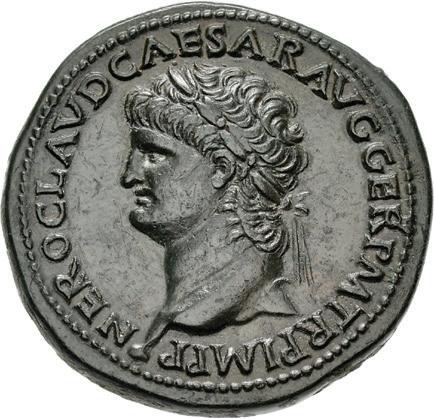

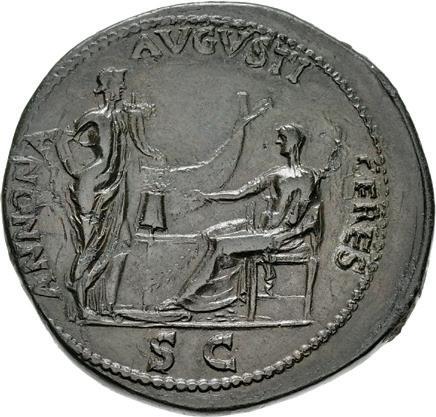
706. Nero. AD 54-68. Æ Dupondius (30mm, 13.40 g, 6h). Lugdunum (Lyon) mint. Struck circa AD 67. IMP • NERO
• CAESAR • AVG • P • MAX • TR • P • P • P, laureate head right, globe at point of neck / SECVRITAS AVGVSTI, S C in exergue, Securitas seated right, resting right elbow on back of chair, right hand to head, holding scepter in left; garlanded and lighted altar to right, against which leans lighted torch. RIC I 596; WCN 531; Lyon 210; BMCRE 344-6; BN 192-3. Attractive river patina, flan crack. EF. ($2500)
Ex Classical Numismatic Group 81 (20 May 2009), lot 996.


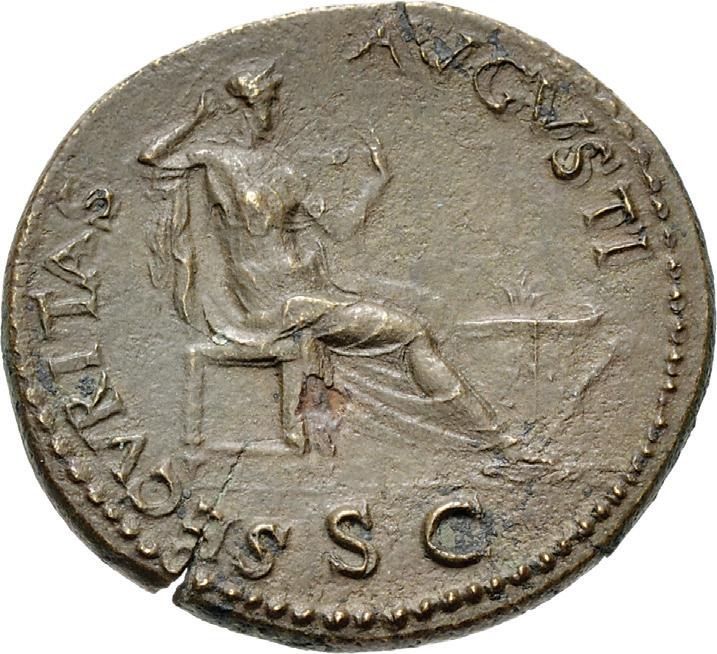
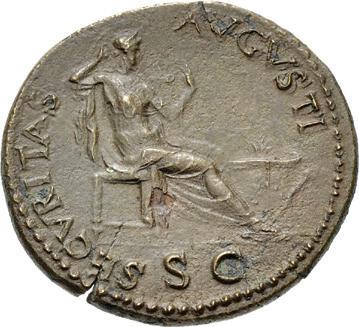



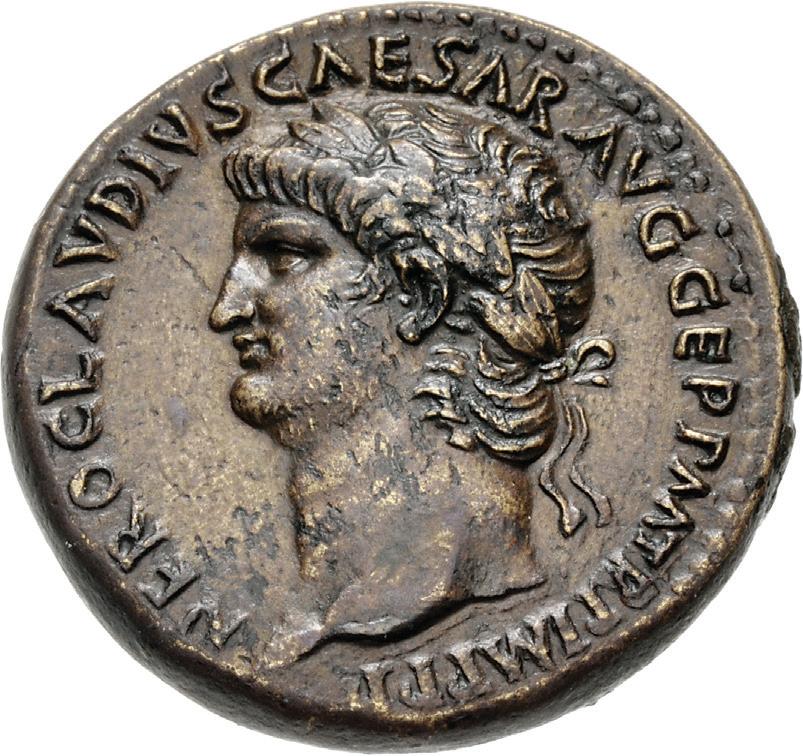
711. Nero. AD 54-68. Æ Sestertius (34.5mm, 26.23 g, 6h). Rome mint. Struck circa AD 67. IMP NERO CLAVD CAESAR AVG GERM P M TR P XIII P P, laureate head right wearing aegis / ROMA in exergue, S C across field, Roma seated left on cuirass, holding Victory and spear; various shields around and to right. RIC I 360 var. (bust type); BMCRE –; BN –; WCN 167 var. (same); CNG 50, lot 51 (same dies). Natural dark brown and red patina, minor doubling. Near EF. A rare bust variety on an issue with a desirable legend. ($5000)
From the DMS Collection, purchased from David Vagi in 2005.
718. Galba. AD 68-69. Æ Sestertius (36mm, 26.42 g, 6h). Rome mint, 4th officina. Struck circa June-August AD 68. SER GALBA IMP CAES AVG TR P, laureate head right / Roma seated left on cuirass, foot on helmet, holding spear and resting arm on shield; two greaves and bow to right. RIC I 244; ACG 251 (A138/P36). Dark brown patina, some roughness. Good VF. ($1000)


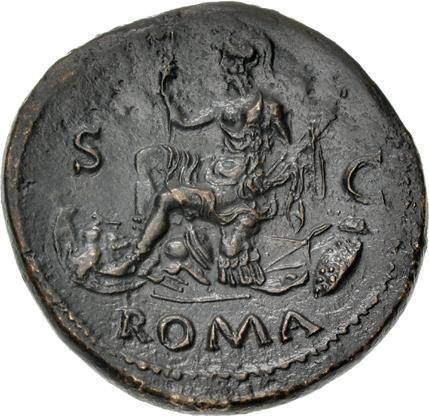


Ex Naville Numismatics 66 (27 June 2021), lot 397.

731. Vespasian. AD 69-79. Æ Sestertius (33mm, 24.01 g, 6h). Rome mint. Struck AD 77-78. IMP CAES VESPASIAN AVG P M TR P P P COS VIII, laureate head right; eagle inset of the d’Este family behind head / ANNONA AVGVST, S C across field, Annona, draped, seated left, holding open on her lap a bag of grain ears, the ends held in her hands. RIC II 987; BMCRE 730 (this coin illustrated); BN 768. Even brown surfaces. Host coin VF, inset Good VF. Rare. ($3000)
From the DMS Collection, purchased from Harlan J. Berk, January 2003. Ex Henry Platt Hall Collection (Part II, Glendining, 16 November 1950), lot 1173; Theodor Prowe Collection (28 November 1904), lot 2391; D’Este Collection, formed initially by Leonello d’Este (14071450), Marquis of Ferrara.
For many centuries, numismatists and scholars have debated the attribution of the distinctive eagle collector’s mark, found on the obverse of a small number of predominantly Greek and Roman coins. Attribution has been generally divided between two Italian noble families: the Gonzag’s, rulers of Mantua, which proclaims itself as the birthplace of the poet Virgil, and the Este family of Ferrara in northern Italy, who could trace their ancestry back to the 10th century. Much of the confusion stems from the intermingling of the Gonzaga and Este family collections in the 17th century. During the War of the Mantuan Succession (1628-1631), the Gonzaga coin collection was used as collateral by the embattled Duke Charles II Gonzaga of Nevers (1609-1631). It was during this tumultuous time in late Renaissance Italy that the Este family acquired the Gonzaga collection. The Gonzaga’s subsequently failed to recover their collection from the Este’s. Leonello d’Este (14071450) Marquis of Ferrara, initially formed what grew into a massive generational collection that was passed down through the Este family for centuries. Leonello began his collection with mostly bronze coins, such as the example offered here. Leonello acquired these earliest coins as a young man prior to 1430. Ercole I d’Este (1431-1505), Leonello’s half-brother, and Duke of Ferrara from 1471-1505, owned a collection of 437 gold coins by 1494. Some were notably acquired from the collection of Pope Paul II (d. 1471). Ercole’s son, Alfonso I d’Este, Duke of Ferrara from 1505-1534, enlisted the assistance of the lauded artist Raphael (painter of the famous The School of Athens in the Vatican library) to help him track down “antique medals, heads and figures.” A rough catalogue of the d’Este family collection was compiled between 1538-1541 under the direction of Ercole II d’Este (1508-1559), Duke of Ferrara from 1534-1559. The 1541 catalogue lists 783 ancient gold coins in the collection.


The collection continued to expand and reached its zenith under Alfonso II d’Este (1533-1597), Duke of Ferrara from 1559-1597.Some of the gold coins that are known today that feature the eagle inset appear in the 1541 manuscript. The absence of some of the coins that today bear the eagle inset supports a date for the inset’s application sometime after 1541. Enea Vico (1523-1567), who directed acquisitions for the d’Este family, referenced the collection in a 1563 writing that makes no mention of the inset. This again supports a slightly later date post 1563. A good possibility for the catalytic event that resulted in the inset’s application to these coins is an exhibition prepared by the famous artist and architect Pirro Ligorio (c.1510-1583). Ligorio, author of a number of famous manuscripts, worked under the patronage of the d’Este family in Ferrara between 1568 and 1574. It was while he worked for the d’Este’s, organizing the duke’s collections in his Antichario, that he compiled many of his famous manuscripts. Ligorio also served as the Vatican’s Papal Architect under Popes Paul IV and Pius IV.
From this evidence, scholars have concluded that the eagle inset did indeed belong to the Este family and was likely applied sometime between 1563-1614, perhaps during the tenure of Pirro Ligorio’s employment from 1568-1574. Later, in 1647, the Este’s recovered 710 pawned aurei with the eagle inset. Additionally, out of the 12,000–15,000 coins which at one time constituted the collection in its entirety, only around 1,500 were chosen to bear the eagle inset, applied in either silver or gold. Bronze coins, such as this one, are less commonly found from the d’Este collection wearing the eagle inset. Portions of the d’Este collection made their way into collections and museums in Milan, Modena, and Paris, as well as in Queen Christina of Sweden’s (1626-1689) personal cabinet of Roman coins. Apart from those collections, the remaining coins featuring the inset irregularly and infrequently appear on the market, such as this example which has been in sales since 1904. This is a rare chance to own a rare coin from a verifiable, famous, and coveted 15th century collection.

734. Divus Vespasian. Died AD 79. Æ Sestertius (33.5mm, 25.78 g, 6h). Rome mint. Struck under Titus, AD 80-81. DIVO/ AVG/ VESP in three lines in upper right field, S P Q R in exergue, radiate statue of of Vespasian seated right on ornate stool, holding long scepter in right hand and Victory, holding palm frond and wreath, in extended left hand, set on ornate car tdrawn by four elephants, each with its own mahout / IMP T CAES DIVI VESP F AVG P M TR P P P COS VIII around large S • C. RIC II.1 257 (Titus) (same dies); BMCRE 222 (Titus); BN 231 (Titus). Green patina, some minor smoothing, minor marks and deposits. VF. ($2000)
From the DMS Collection. Ex Robert O. Ebert Collection (Stack’s Bowers and Ponterio 174, 12 January 2013), lot 6121.
The unusual obverse of this sestertius likely depicts a scene from Vespasian’s funeral cortege, showing his radiate effigy being pulled behind a quadriga of elephants. Another variety depicts a closer view of the statue, which appears to be considerably larger than life-sized. As the first emperor successful enough to have merited deification since Claudius, his funeral was surely a major public event, and the mourning for the stability he brought was likely sincere. The funerals of deified Roman emperors typically ended with the waxen effigy being burned atop an enormous tiered pyre, from which an eagle is released to symbolized his spirit’s ascent to the heavens.
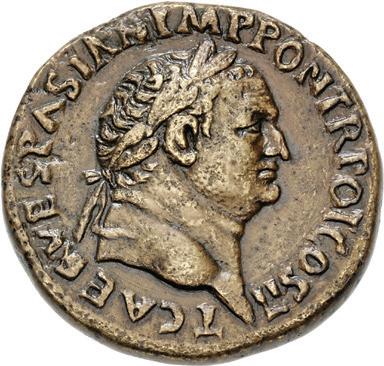



736. Titus. As Caesar, AD 69-79. Æ Sestertius (32mm, 25.05 g, 7h). “Judaea Capta” commemorative. Rome mint. Struck under Vespasian, AD 72. T CAES VESPASIAN IMP PON TR POT COS II, laureate head right / IVDAEA CAPTA, S C in exergue, palm tree; to left, Titus standing right, left foot on helmet, holding spear in right hand, cradling parazonium in left arm; to right, Judaea seated right on cuirass, in attitude of mourning. RIC II.1 422; Hendin 6553; BMCRE 631-2; BN 618. River patina, smoothing and minor tooling. VF. Powerful portrait. ($3000)
From the Dr. Jay M. Galst Collection; Ex Leo Benz Collection (Lanz 94, 22 November 1999), lot 348.
738. Titus. As Caesar, AD 69-79. Æ Sestertius (33.5mm, 25.66 g, 7h). “Judaea Capta” commemorative. Rome mint. Struck under Vespasian, AD 73. T CAES VESP IMP PON TR POT COS II CENS, laureate head right / S • C in exergue, Titus standing right in triumphal quadriga right, holding branch in right hand and scepter in left; on currus, relief of Victory holding wreath and palm frond. RIC II.1 611 (Vespasian, same rev. die); Hendin 6572 (Vespasian, same dies); BMCRE 668 (Vespasian, same dies). River patina, well struck, some minor areas of erosion, deposit. VF. Very rare. ($3000)


From the DMS Collection, purchased from David Hendin, July 1998.
When Vespasian was acclaimed Emperor by the eastern legions on 1 July AD 69, he left his son Titus in command of ongoing operations to repress the Jewish Revolt (AD 66-73). Like his father, Titus was a skilled general and, by April AD 70, he had forced the rebels behind the walls of Jerusalem, which he besieged for four months and ultimately demolished, setting the Temple ablaze. Although mopping up operations against surviving rebel elements continued, Titus traveled to Rome in AD 71 to celebrate a formal triumph as Caesar alongside his father. Despite its lack of any legend other than S C (Senatus Consulto), the reverse of this sestertius belongs to the “Judaea Capta” Flavian propaganda program in its depiction of Titus riding serenely in the triumphal chariot, drinking in the adulation of the Roman people.
Enlargement of Lot 734
Enlargement of Lot 736



Enlargements of Lot 738

748. Domitian. AD 81-96. Æ Sestertius (34mm, 23.47 g, 6h). Rome mint. Struck AD 95-18 September 96. IMP CAES DOMIT AVG GERM COS XVII CENS PER P P, laureate head right / IOVI VICTORI, S C in exergue, Jupiter, naked to hips, seated left, holding Victory in extended right hand and vertical scepter in left. RIC II.1 794; BMCRE 474-5; BN 504-5. Handsome river brown surfaces, a few minor flan flaws. EF. ($5000)

Ex Numismatica Ars Classica 59 (4 April 2011), lot 1932 (hammer CHF 7000).
749. Nerva. AD 96-98. Æ Sestertius (34mm, 26.44 g, 6h). Rome mint. Struck AD 96. IMP NERVA CAES AVG P M TR P COS II DESIGN III P P, laureate head right / CONCORDIA EXERCITVVM, clasped hands; legionary aquila set on prow of galley behind. RIC II 70; Banti 6 (this coin); BMCRE p. 17, §; Mazzini 27 = L. G. P. Messenger, “Some Further Unpublished Roman Bronze Coins in my Collection” in NC 1933, 8 (this coin). Red-brown patina, some roughness, minor smoothing in fields. VF. Very rare, only two in CoinArchives, one known to Banti. ($1500)
Ex Roma E-Sale 85 (17 June 2021), lot 1678; Áureo & Calicó 311 (31 May 2018), lot 42; Classical Numismatic Group Electronic Auction 156 (17 January 2007), lot 173; Tony Hardy Collection (Classical Numismatic Group 67, 22 September 2004), lot 1402; Giuseppe Mazzini Collection; Leopold G. P. Messenger Collection; Ratto 4 (11 March 1933), lot 226; Clarence S. Bement Collection (Ars Classica VIII, 25 June 1924), lot 799; Gustave Burel Collection (Feuardent, 11 June 1913), lot 517.
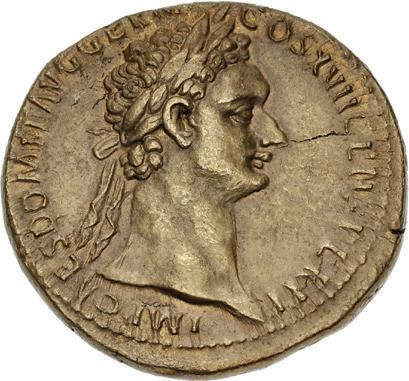

751. Nerva. AD 96-98. Æ Sestertius (33mm, 28.58 g, 6h). Rome mint. Struck AD 97. IMP NERVA CAES AVG P M TR P COS III P P, laureate head right / FORTVNA AVGVST, S C across field, Fortuna standing left, holding rudder in right hand and cornucopia in left. RIC II 83; Banti 21; BMCRE 107-8; BN 98. Attractive original green and brown patina. Good VF. ($5000)
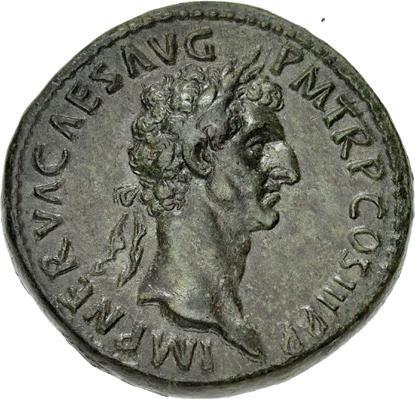

From the DMS Collection. Ex CNG inventory 944074 (May 2013); Numismatica Genevensis SA VII (27 November 2012), lot 358 .

Enlargements of Lot 748


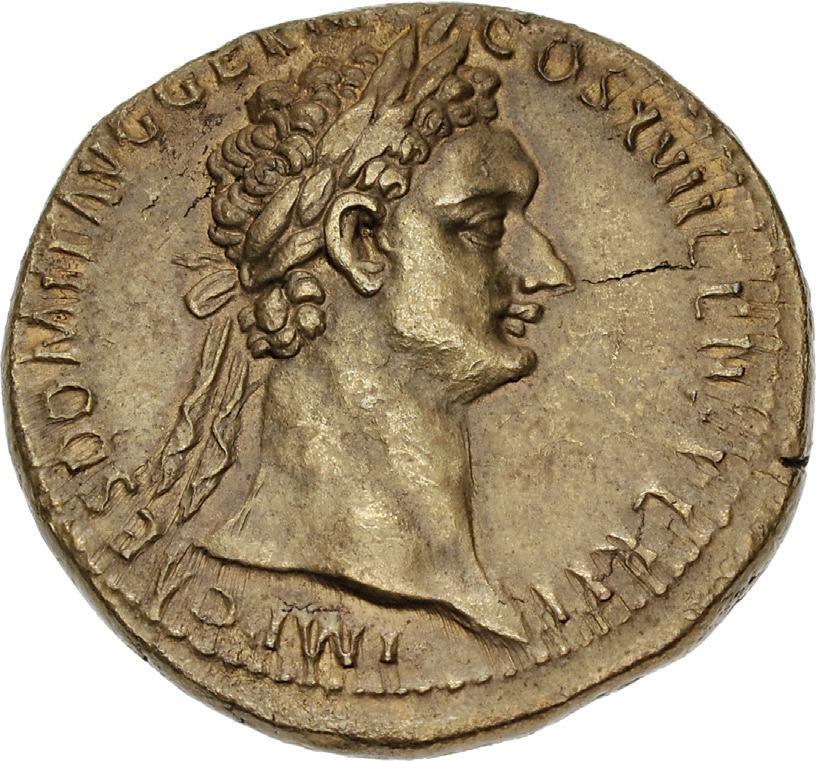

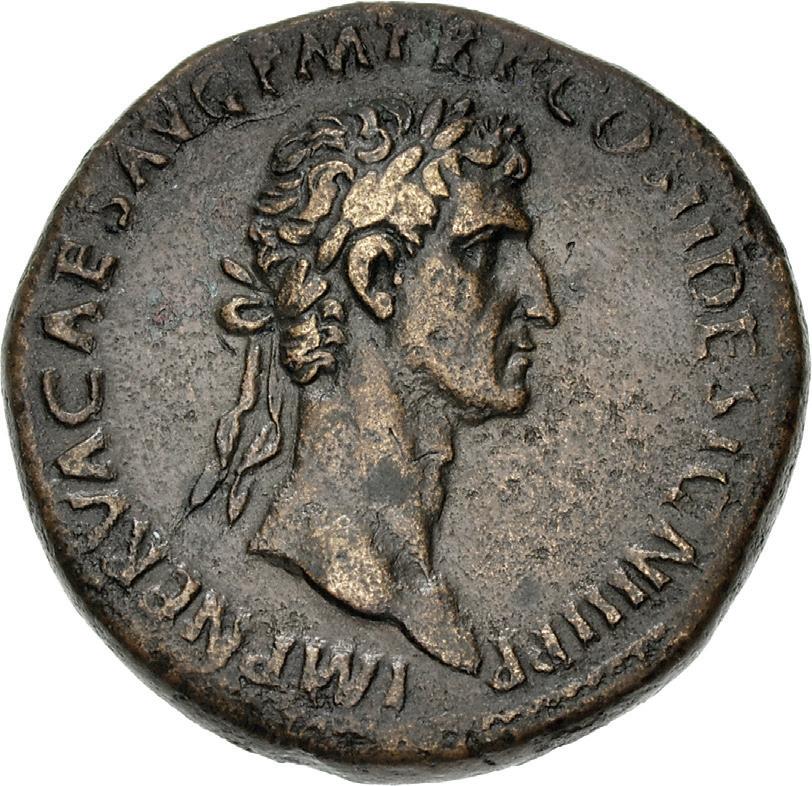
Enlargements of Lot 749 Enlargements of Lot 751

752. Trajan. AD 98-117. Æ Sestertius (34.5mm, 23.91 g, 6h). Rome mint. Struck AD 101-102. IMP CAES NERVA TRAIAN AVG GERM P M, laureate bust right, slight drapery / TR POT COS IIII P P, S C in exergue, Pax, draped, seated left on throne, holding olive branch in extended right hand and transverse scepter in left. RIC II 432 var. (bust type); Woytek 107b; Strack 338; Banti 337; BMCRE 745, note; BN 144-5. Glossy green patina. Choice EF. Boldly struck, with a magnificent portrait. A first class bronze. ($15,000)
When Trajan entered his fourth consulship in AD 101, the Roman Empire seemed securely at peace, as celebrated by the figure of Pax on the reverse of this attractive sestertius. These allusions were possibly a ruse, however, as Trajan was already planning a massive campaign against the Dacian King Decebalus, who had humiliated Roman armies on two occasions during Domitian’s reign.

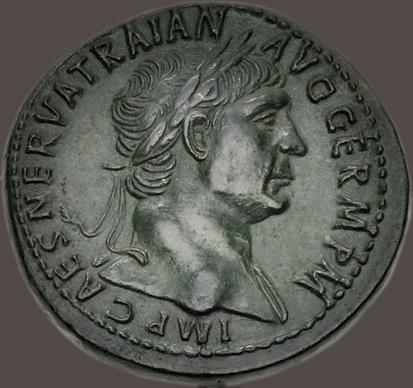
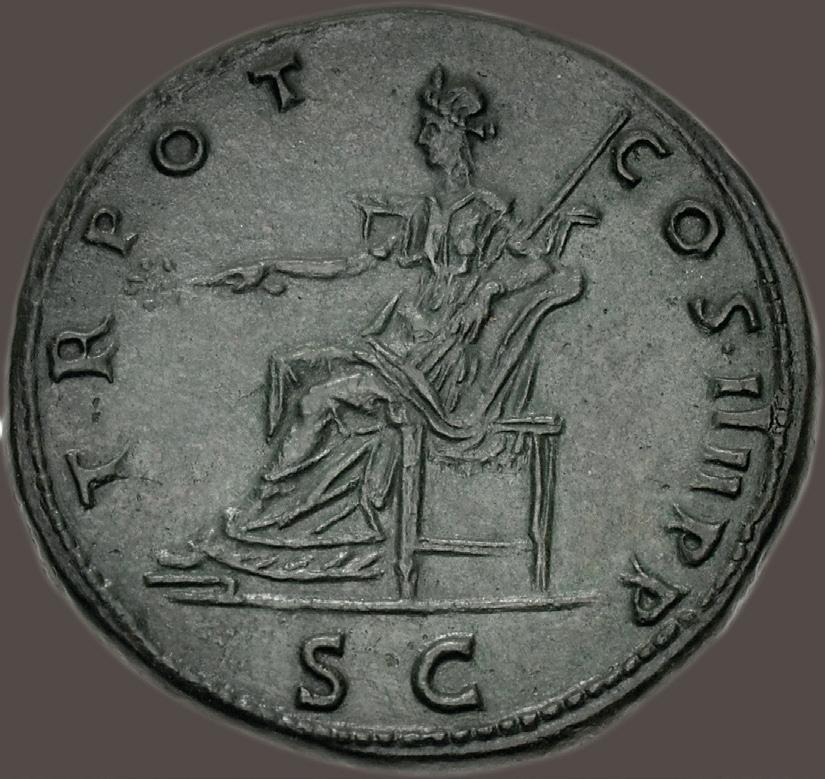



755. Trajan. AD 98-117. Æ Sestertius (33mm, 26.68 g, 6h). Rome mint. Struck circa AD 112/3-114. IMP CAES NERVAE TRAIANO AVG GER DAC P M TR P COS VI P P, laureate head right / S P Q R OPTI MO PRINCIPI, S C across field, Trajan’s column surmounted by statue of Trajan, holding patera and scepter; two eagles at base; relief in base and pediment. RIC 601; Woytek 472a (same dies); Banti 296; BMCRE 971 note; BN 761. Even brown surfaces with some areas of red, minor edge chip. Good VF. Rare. ($2000)




From the DMS Collection, purchased from Harlan J. Berk, August 2008.
Trajan excelled in civilian government and understood the importance of public works. One of his most famous was the column bearing his name, which st…ill stands today. His conquest of Dacia in AD 102-105 can be followed on the spiral reliefs of Trajan’s Column, and brought an enormous windfall of plunder into the Roman economy, financing construction of his enormous new Forum, for which the column served as a centerpiece. This sestertius was struck to celebrate completion of the column, and the relief is readily apparent. Trajan’s mortal remains were later entombed under its base.
756. Trajan. AD 98-117. Æ Sestertius (34.5mm, 27.53 g, 6h). Rome mint. Struck winter AD 114-early 116. IMP CAES NER TRAIANO OPTIMO AVG GER DAC P M TR P COS VI P P, laureate and draped bust right / IMPERATOR VIIII/ S C in two lines in exergue, Trajan seated right on sella castrensis set on high platform, two officers at his side, raising right hand haranguing a group of four soldiers, one of them holding a horse by the bridle, in front of him on the ground stands an officer right, holding spear; an aquila and two signa in the background. RIC II 658; Woytek 549v; Strack 464ζ; Banti 80; BMCRE 1019-20; BN 844. Some smoothing, red-brown earthen deposits on edge. Good VF. ($1000)


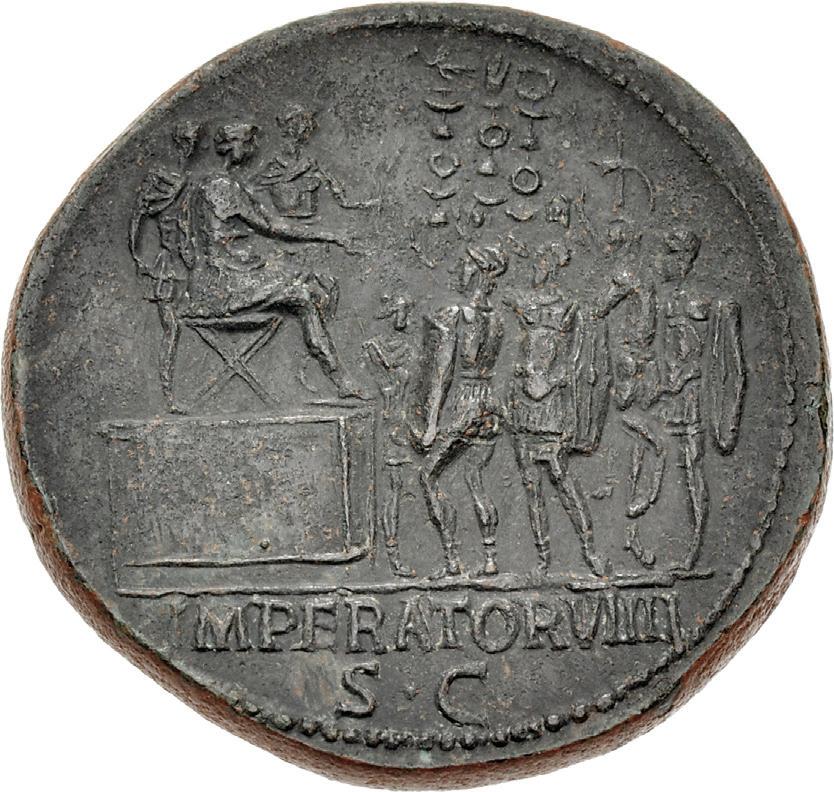
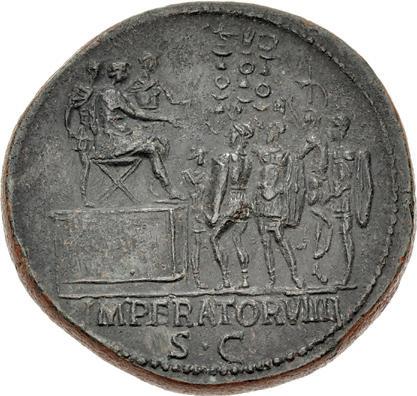
760.
Ex Numismatica Ars Classica 52 (7 October 2009), lot 425; Tkalec (22 April 2007), lot 222.
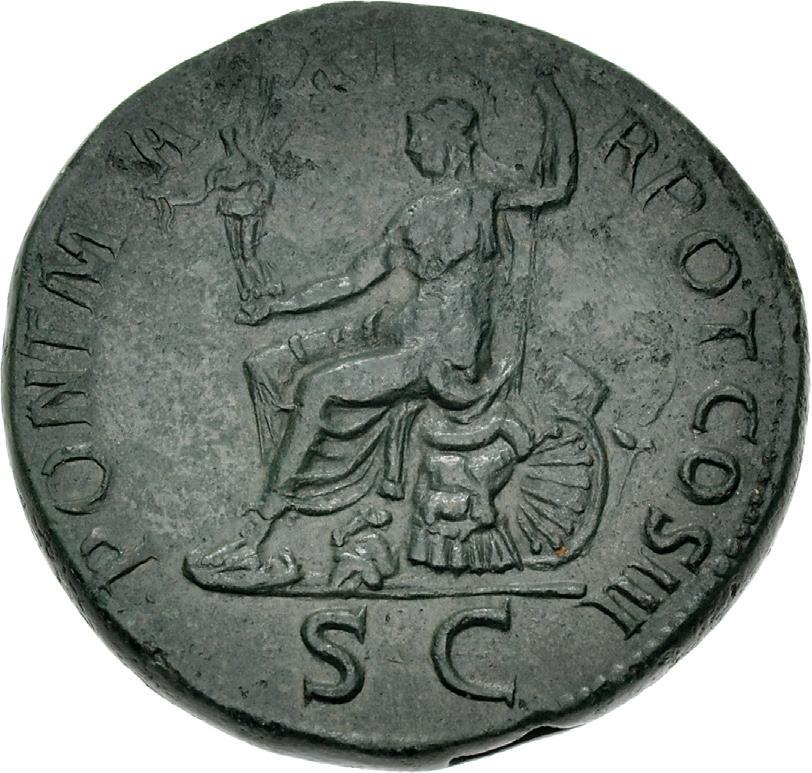


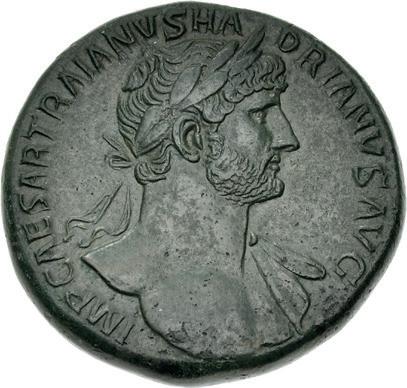
765. Hadrian. AD 117-138. Æ Dupondius/As (26.5mm, 11.35 g, 6h). Rome mint. Struck circa AD 129-130. HADRIANVS AVGVSTVS, bareheaded and draped bust right / FELICITATI AVG, S C across field, COS III P P in exergue, galley left with steersman and and five rowers; at stern, acrostolium, arch over steersman, signum and vexillum; at prow, mast slanted forward and sail. RIC II.3 1333; Strack 839; BMCRE 1458 var. (number of rowers). Green-brown patina, smoothing in fields. Near EF. ($1000)

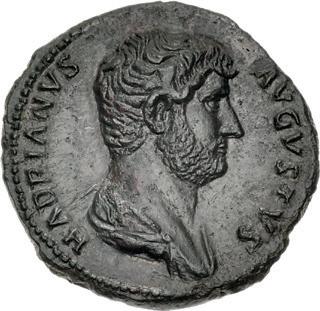

Ex CNG inventory 720852 (June 2000); Leu 77 (11 May 2000), lot 551.

768. Antoninus Pius. AD 138-161. Æ Sestertius (33mm, 23.97 g, 12h). Rome mint. Struck circa AD 141-143. ANTONINVS AVG PI VS P P TR P COS III, laureate head right / TIBERIS, S C in exergue, Tiber reclining left on overturned urn from which water flows, right hand resting on boat, cradling reed in left arm; waves beneath. RIC III 642a; Banti 414 var. (break in obv. legend); BMCRE 1313-4 var. (no waves); Mazzini 819 var. (break in obv. legend). Dark brown surfaces, hints of smoothing, flan flaw, a couple of light scratches on reverse. Near EF. Exceptional strike. ($1500)

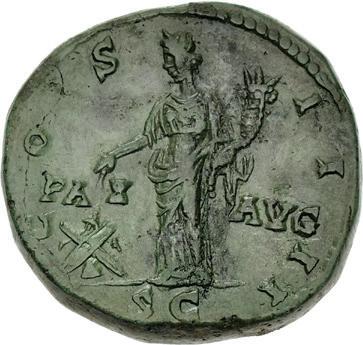
From the DMS Collection, purchased from Harlan J. Berk, January 2003.
Unlike the restless Hadrian, Antoninus never left Italy during his reign and was content to rule from Rome. Stability and equanimity were his watchwords, and his policies kept the Empire on an even keel for 24 years. Although his coinage does refer to other provinces, Italy and Rome predominate, as with this sestertius with an elegant reclining figure representing the River Tiber.
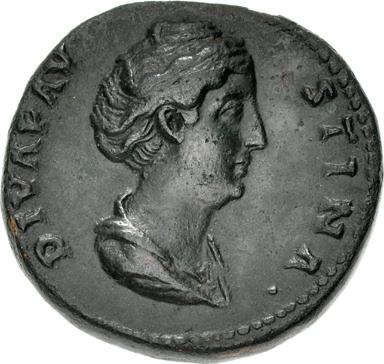

769. Antoninus Pius. AD 138-161. Æ Sestertius (31mm, 26.37 g, 11h). Rome mint. Struck circa AD 145-147. ANTONINVS AVG PIVS P P TR P •, laureate head right / COS II II, PAX AVG across field, S C in exergue, Pax standing left, setting fire to heap of arms at her feet to left and holding cornucopia in left. RIC III –; Strack –; Banti 264 (same rev. die as illustration); BMCRE 1703. Wonderful apple green patina. Good VF. Extremely rare, only the British Museum example noted by Banti and only this example in CoinArchives. ($1500)
Ex Triton X (9 January 2007), lot 633.
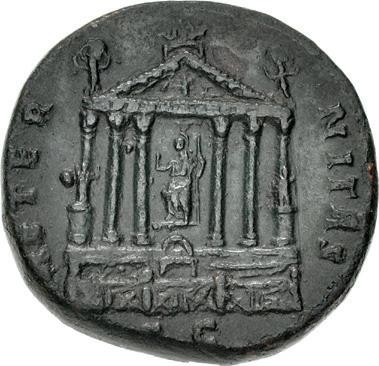

773. Diva Faustina Senior. Died AD 140/1. Æ Sestertius (30.5mm, 25.62 g, 6h). Rome mint. Struck under Antoninus Pius, circa AD 146-161. DIVA FAV STINA, draped bust right, hair bound in pearls / AETER NITAS, S C in exergue, temple of Diva Faustina: façade of hexastyle temple on podium of three steps, railing in front, statues before outer columns, relief in base and pediment, quadriga and Victories as acroteria; within, statue of Faustina seated left, holding globe in right hand and spear in left. RIC III 1115a (Antoninus Pius); Banti 27 (this coin illustrated); BMCRE 1506 (Antoninus Pius). Dark green patina, some smoothing. VF. ($1000)
From the DMS Collection. Ex CNG inventory 998515 (April 2015); Morton & Eden 72 (15 December 2014), lot 112; Galerie des Monnaies (9 June 1978), lot 1745.
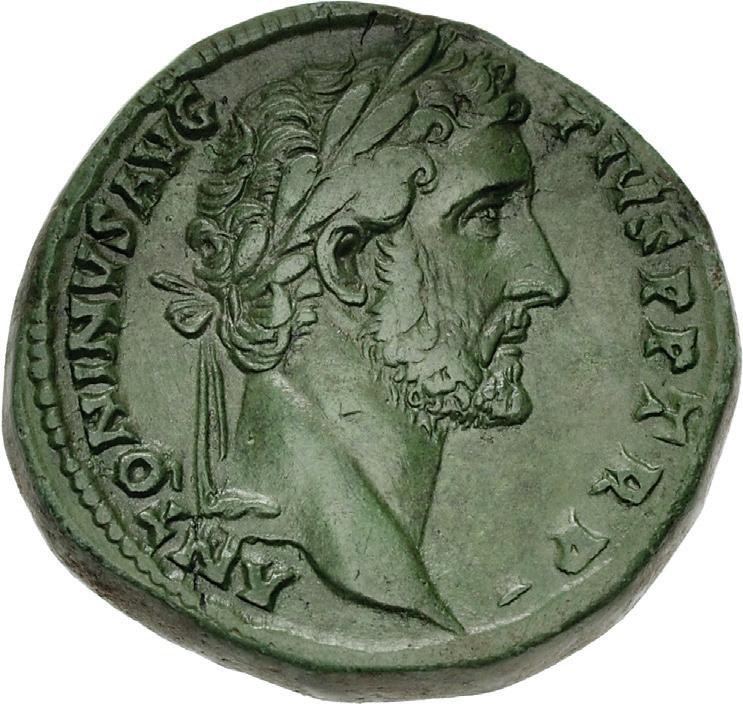


775. Marcus Aurelius. AD 161-180. Æ Sestertius (32mm, 28.39 g, 12h). Rome mint. Struck AD 162. IMP CAES M AVREL ANTONINVS AVG P M, laureate and cuirassed bust right / CONCORD AVGVSTOR TR P XVI, S C across field, COS III in exergue, Marcus Aurelius and Lucius Verus, both togate, standing facing each other, clasping right hands and each holding volumen in left. RIC III 824 var. (bust type); MIR 18, 30-6/35; Banti 37; BMCRE 1008 var. (same). Even brown surfaces. Near EF. Rare bust type. Banti records only two examples. ($3000)
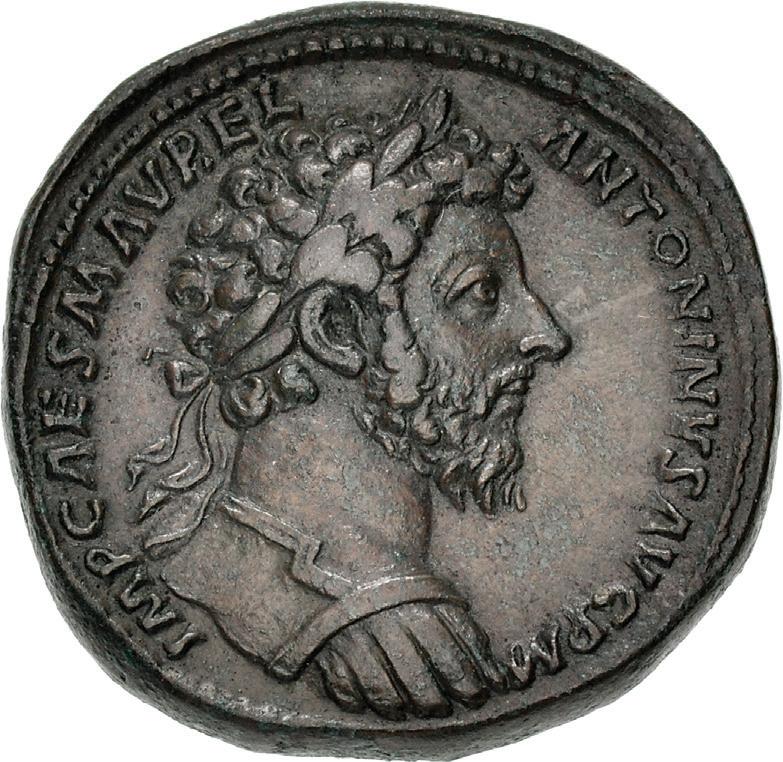
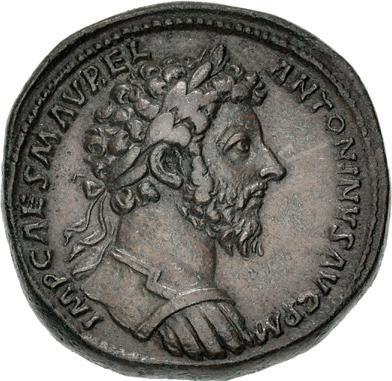

From the DMS Collection. Ex CNG inventory 162082 (January 2006); Lanz 125 (28 November 2005), lot 785 (conserved since); P.H. Webb Collection (A. Hess, 9 May 1932), lot 2213.

783. Commodus. AD 177-192. Æ Sestertius ( 27mm, 21.38 g, 7h). British Victory issue. Rome mint. Struck AD 185. M COMMODVS ANT ON AVG PIVS BRIT, laureate head right / P M TR P X IMP VII COS IIII P P, S C across field, VICT BRIT in exergue, Victory seated right on shields, cradling palm frond in right arm, and placing left hand on shield set on knee; two shields on ground to left. RIC III 452; MIR 18, 665-6/30 var. (rev. legend); Banti 485; BMCRE 560; SCBC 648. Warm brown surfaces, well struck, minor smoothing. VF. ($1000)
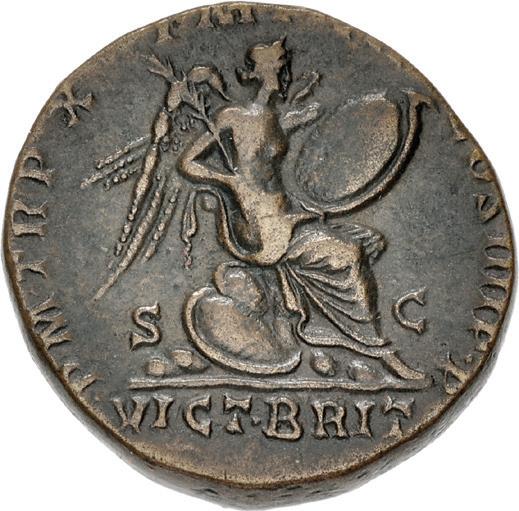


From the DMS Collection.
Cassius Dio records a serious uprising in Britannia just before or after the death of Marcus Aurelius and Commodus becoming sole emperor. The rebels defeated and killed a Roman general (possibly the governor, Caerellius Priscus) and breached Hadrian’s wall, causing widespread havoc. Commodus sent the previous governor, Ulpius Marcellus, with reinforcements to restore order, but this was not fully accomplished until circa AD 184. This sestertius records the “Victory in Britannia” and awards Commodus the title Britannicus, although he never left Rome during the war.


787.
193-211.
59.51
1h).
mint. Struck AD 194. L • SEPTIMIVS • SEVERVS PERTINAX •
IIII,
/ [P] M TR P III
• MILIT in exergue,
hand raised in
and holding scepter with left; behind him, Caracalla and Geta, both in military attire, standing left; before, six soldiers standing right, the front row holding shields, the back row holding two signa and a vexillum. Gnecchi II, 16 (pl. 94, 7); Banti 51; Cohen 152; Grueber 3; Froehner p. 153. Attractive dark green and brown patina, some minor roughness. Good VF. Extremely rare and impressive. ($20,000)
Ex Triton XX (10 January 2017), lot 786; Gorny & Mosch 232 (5 October 2015), lot 456.
Although Septimius Severus is often described as first of the “soldier emperors,” his early career was almost entirely civilian, rising steadily through the ladder of Roman magistracies, much like his predecessors. Nevertheless, his reign proved a major step in militarizing Roman government and life. He entered the Senate in AD 173 and gained some early military experience as legionary officer in Africa and Syria, where he served under the later Emperor Pertinax. After reaching the Consulship in AD 190, he was appointed as governor of Pannonia Superior, which placed him in command of Legio XIV Gemina Martia Victrix, strategically located within easy march of Italy and Rome. With the assassination of Commodus in AD 193, followed within weeks by the murder of his mentor Pertinax, Severus was hailed as emperor by the XIVth at Carnuntum. A lightning march to Rome deposed the pathetic Didius Julianus and placed Severus in firm control of the capital, whereupon he immediately prepared for civil war against two rivals who had likewise been proclaimed in the provinces, Clodius Albinus and Pescinnius Niger. Though wealthy and connected, Severus was from a “new” family and relied heavily on the army to cement his power. He raised military pay and showed his troops many preferments, including ending the longtime ban on marriage for regular soldiers. The army began to think of him as one of their own and, after disposing of Niger and Albinus, he suffered no revolts or serious internal threats for the rest of his reign. This remarkable bronze medallion, struck in AD 194 for presentation to a senior officer, depicts Severus being hailed as Imperator (victorious general) by his soldiers. Behind him stand his sons, Caracalla and Geta, whom he told on his deathbed, “get along with one another, enrich the soldiers, and despise everyone else!”

793. Caracalla. AD 198-217. Æ Sestertius (32mm, 29.06 g, 6h). Rome mint. Struck under Septimius Severus, AD 210. M AVREL ANTONI NVS PIVS AVG, laureate bust right, slight drapery / PONTIF TRP X III COS III, SC across field, Mars advancing left, holding olive branch in outstretched right hand and cradling trophy in left arm. RIC IV 450b; Banti 87; BMCRE 203; SCBC –. impressive hard brown patina, hairline flan crack, double strike on reverse. Near EF ($3000)
Ex Triton XXII (8 January 2019), lot 1127; Distinguished Collection of Roman Bronze Coins (Dix, Noonan, Webb 139, 15 February 2017), lot 147 (hammer £5000); A. Hess [230] (28 April 1936), lot 1553.

This sestertius celebrates the Severan campaign in Britain circa AD 208-211, the last Roman attempt to conquer Caledonia, now called Scotland, thereby controlling the entire island. Septimius Severus mounted the expedition in mid AD 208, hoping for a quick victory to crown his later years, and also to curb the ferocious sibling hatred of his sons, Caracalla and Geta, who accompanied him. Caracalla took the opportunity to play common soldier and ingratiate himself with the legions, while Geta took an administrative role in York. But what was supposed to be an easy conquest turned into a long, bitter slog, which took its toll on the emperor’s health and intensified the brothers’ mutual hatred. Severus died at York on 4 February AD 211. Caracalla and Geta quickly abandoned Scotland, declared victory, and returned to Rome.
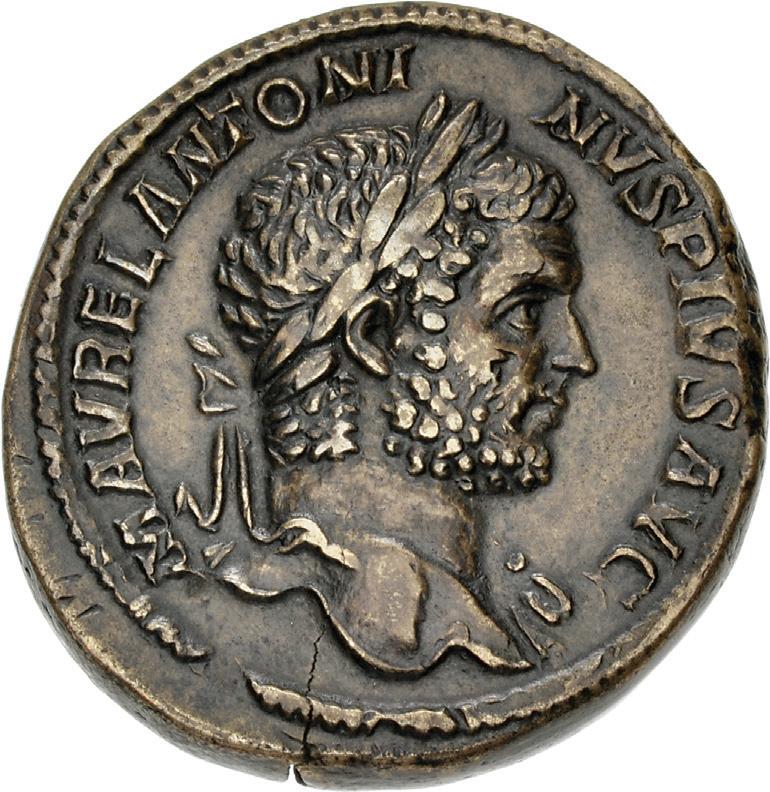


799. Balbinus. AD 238. Æ Sestertius (31mm, 19.53 g, 12h). Rome mint. 1st emission. IMP CAES D CAEL BALBINVS AVG, laureate, draped, and cuirassed bust right / P M TR P COS II P P, Balbinus, togate, standing left, holding branch in right hand and parazonium in left. RIC IV 16; BMCRE 28; Banti 7. Brown patina. Good VF. Well centered. ($3000)


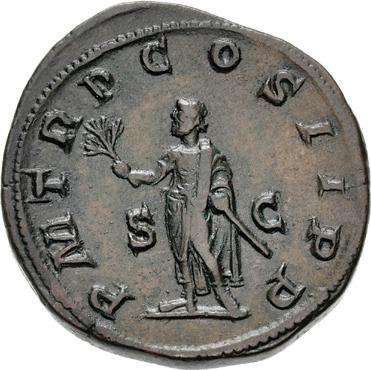
Ex Classical Numismatic Group 87 (18 May 2011), lot 1055.

806. Trajan Decius. AD 249-251. Æ Double Sestertius (36.5mm, 47.64 g, 11h). Rome mint, 5th officina. 2nd-3rd emissions, late AD 249-mid 250. IMP C M Q TRAIANVS DECIVS AVG, radiate and cuirassed bust right / VICTORIA AVG, S C across field, Victory advancing left, holding wreath in right hand and palm frond in left. RIC IV 126a; Banti 29; Gnecchi III, 6. Dark green patina, areas of roughness, some minor marks, some deposits. Good VF. Rare. ($3000)
From the DMS Collection, purchased from Jonathan K. Kern, 2012. Ex Gemini I (11 January 2005), lot 424.
An attractive and overweight specimen. Bastien recorded a number of Trajan Decius double sestertii and their weights in 1967. Of those listed, only one is heavier than the present example. None of the examples in Coin Archives are heavier than this impressive coin.





